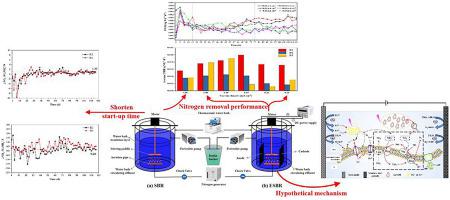当前位置:
X-MOL 学术
›
Chemosphere
›
论文详情
Our official English website, www.x-mol.net, welcomes your
feedback! (Note: you will need to create a separate account there.)
Nitrogen removal performance and rapid start-up of anammox process in an electrolytic sequencing batch reactor (ESBR)
Chemosphere ( IF 8.1 ) Pub Date : 2022-09-01 , DOI: 10.1016/j.chemosphere.2022.136293
Yuyu Lu 1 , Juanting Wang 2 , Yan Feng 1 , Honglan Li 1 , Zhongwei Wang 3 , Hao Chen 4 , Ning Suo 1 , Yanzhen Yu 5 , Shoubin Zhang 1
Chemosphere ( IF 8.1 ) Pub Date : 2022-09-01 , DOI: 10.1016/j.chemosphere.2022.136293
Yuyu Lu 1 , Juanting Wang 2 , Yan Feng 1 , Honglan Li 1 , Zhongwei Wang 3 , Hao Chen 4 , Ning Suo 1 , Yanzhen Yu 5 , Shoubin Zhang 1
Affiliation

|
In this study, the electrolytic sequencing batch reactor (ESBR) with different current densities was constructed to investigate the nitrogen removal performance and rapid start-up of anaerobic ammonia oxidation (anammox) process. The changes of total nitrogen removal rate (TNRR), specific anammox activity (SAA) and nitrogen concentration under different current densities were analyzed, and then the effect of the optimal current density on the start-up of anammox in ESBR was explored. The results showed that ammonium nitrogen removal efficiency (92.7%), nitrite nitrogen removal efficiency (15.5%) and total nitrogen removal efficiency (28.1%) were obtained with the TNRR and SAA were 0.0118 g N L−1 d−1 and 0.0050 g N (g Vss d)−1 , respectively under the optimal conditions (i.e., current density = 0.10 mA cm−2 , temperature = 36 °C and pH = 7.6). In addition, the stoichiometric ratio indicated that anammox was initiated successfully for 91 days in ESBR with the current density of 0.10 mA cm−2 , which was shortened by 10 days compared with the conventional SBR without current density. These results suggest that an array of rapid start-up processes of anammox can be developed through applying current density to stimulate the activity of anammox bacteria (AnAOB).
中文翻译:

电解序批式反应器 (ESBR) 中的脱氮性能和厌氧氨氧化工艺的快速启动
本研究构建了不同电流密度的电解序批式反应器 (ESBR),以研究厌氧氨氧化 (anammox) 工艺的脱氮性能和快速启动。分析了不同电流密度下总氮去除率 (TNRR) 、比厌氧氨氧化活性 (SAA) 和氮浓度的变化,进而探讨了最佳电流密度对 ESBR 中厌氧氨氧化启动的影响。结果表明,在最佳条件下(即电流密度 = 0.10 mA cm-2,温度 = 36 °C 和 pH = 7.6),TNRR 和 SAA 获得的铵态氮去除效率 (92.7%)、亚硝酸盐脱氮效率 (15.5%) 和总氮去除效率 (28.1%) 分别为 0.0118 g N L-1 d-1 和 0.0050 g N (g Vss d)-1。此外,化学计量比表明,在电流密度为 0.10 mA cm-2 的 ESBR 中成功引发厌氧氨氧化 91 天,与没有电流密度的常规 SBR 相比缩短了 10 天。这些结果表明,可以通过施加电流密度来刺激厌氧氨氧化菌 (AnAOB) 的活性来开发一系列厌氧氨氧化的快速启动过程。
更新日期:2022-09-01
中文翻译:

电解序批式反应器 (ESBR) 中的脱氮性能和厌氧氨氧化工艺的快速启动
本研究构建了不同电流密度的电解序批式反应器 (ESBR),以研究厌氧氨氧化 (anammox) 工艺的脱氮性能和快速启动。分析了不同电流密度下总氮去除率 (TNRR) 、比厌氧氨氧化活性 (SAA) 和氮浓度的变化,进而探讨了最佳电流密度对 ESBR 中厌氧氨氧化启动的影响。结果表明,在最佳条件下(即电流密度 = 0.10 mA cm-2,温度 = 36 °C 和 pH = 7.6),TNRR 和 SAA 获得的铵态氮去除效率 (92.7%)、亚硝酸盐脱氮效率 (15.5%) 和总氮去除效率 (28.1%) 分别为 0.0118 g N L-1 d-1 和 0.0050 g N (g Vss d)-1。此外,化学计量比表明,在电流密度为 0.10 mA cm-2 的 ESBR 中成功引发厌氧氨氧化 91 天,与没有电流密度的常规 SBR 相比缩短了 10 天。这些结果表明,可以通过施加电流密度来刺激厌氧氨氧化菌 (AnAOB) 的活性来开发一系列厌氧氨氧化的快速启动过程。







































 京公网安备 11010802027423号
京公网安备 11010802027423号